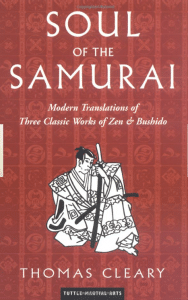Book Report: Soul of the Samurai by Thomas Cleary
Samurai. The word itself conjures images of fearless warriors doing battle and a code of honor that required suicide in the face of dishonor. Samurai
That influence extends to the role-playing game community as well. They wear many names, but samurai and their beliefs appear in many role-playing games, sometimes explicitly as samurai, sometimes cloaked under layers of world-specific names and technology.
Some weeks ago, I realized that I knew surprising little about samurai. I knew a great deal about what they did, but not who they were. I can easily list critical events in Japanese history, how the samurai behaved in day-to-day life and a hundred other bits of historical trivia related to samurai. My issue was these were all externalities. I had no understanding of what went on inside a samurai’s head. Since there are no samurai left, I researched the things samurai studied and went to the source material.
Soul of the Samurai by Thomas Cleary is a translation of three works of Zen and Bushido philosophy. I should mention I call this post a book report because I am totally unqualified to review this work. All I can do is speak to how it might improve a game or add some depth to an RPG character. So rather than summarize the book, I will talk about a couple of key issues in the work that speak to the thinking of a 17th century samurai.
Reluctance is a word rarely applied to samurai, but there is a strong thread of reluctance through the entire text. In several cases referring to weapons as “instruments of ill omen.” Clearly, for all of their skill with a katana, samurai wielded them with the knowledge that using a weapon was an ill-favored act. That said, it also speaks of violence’s necessity at times.
“The killing sword bring life” epitomizes this dichotomy. The logic being that killing a single evil man is better than allowing him to kill hundreds. Violence has its place, loathed though it is.
And when violence happens, clarity of thought matters. It is difficult to summarize the concept, but essentially it is pure, focused thought on a single act. Any thoughts outside of that single concept are a kind of sickness. In fact, even thinking about not thinking about other things is forbidden!
It is this idea that fascinated me the most. Imagine a man, trained from birth to have total focus, total clarity even in the most lethal of circumstance. Taught to ignore everything but the next sword strike or the next block. I cannot imagine the amount of carnage such a man might wreak in single combat.
I cannot hope to transmit even a fraction of this book’s content. It is densely written and a difficult read. For all the effort I put into reading this tome, I truly believe I found some useful insights into the mind of a philosophical warrior. I promise that the next time I play a swordsmen in a game, I will utilize some of these insights to make him a bit more real…and dangerous.
Trask, The Last Tyromancer